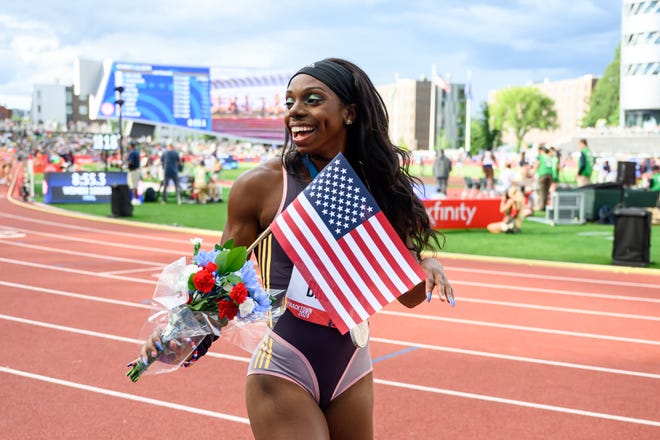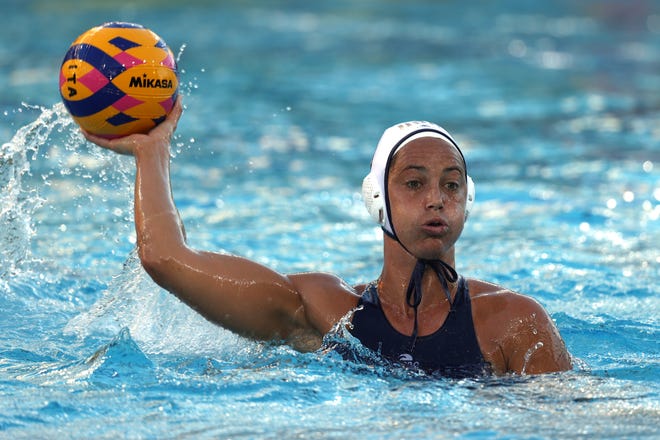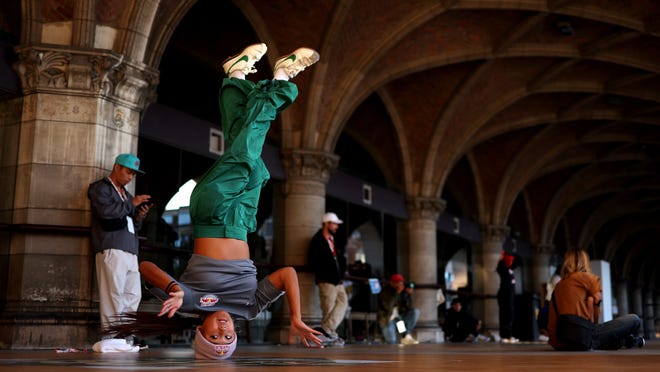
Between babysitting, working as a caregiver for adults with dementia and Alzheimer’s and bussing tables at an Iowa City restaurant, Olympian Brittany Brown still found time for her main job: elite track runner. She just wasn’t getting paid for it − yet.
After graduating from Iowa in 2018, Brown wasn’t ready to hang up her cleats. But as an unsponsored athlete for about a year, she had to cover the cost of living and fund her training.
“I understand what it’s like to be really hustling,” Brown said, and that’s the reality for many other Olympians, too.
It wasn’t until she won a 2019 world championship silver medal that Adidas came calling with sponsorship.
“It was definitely a sigh of relief to have that and to be recognized,” said the 29-year-old Brown, who will compete in the 200-meter race at the 2024 Paris Olympics. “Money is respect, and it was nice to be respected in that way and to be like, ‘OK, cool. She did this cool thing, and she did it unsigned.’”
Meet Team USA: See which athletes made the U.S. Olympic team and where they are from
Get Olympics updates in your texts! Join USA TODAY Sports’ WhatsApp Channel

Brown’s story as a previously unsponsored athlete is far from unique. For many elite athletes, the financial burden of training can be ever present. The Olympians seen in ads for Nike, Gatorade, Visa and Reese’s, among other big-name brands, don’t represent the majority, athletes told USA TODAY Sports.
“The reality is that’s only the top 5%; the rest of us are living paycheck by paycheck,” said water polo player Kaleigh Gilchrist, who’s playing for a third straight Olympic gold medal.
It’s why Maggie Steffens, Team USA’s water polo captain, took to Instagram in May to crowdsource funding, noting that “most Olympians need a 2nd (or 3rd) job to support chasing the dream (myself included!)”. What she didn’t expect was rapper Flavor Flav sponsoring the whole team, inking a five-year sponsorship deal as the official hype man for Team USA women’s and men’s water polo.
Team and individual sponsors help pay for training and competition travel, stateside and abroad, along with fundraisers. National governing bodies − such as USA Track and Field − and the United States Olympic and Paralympic Committee also can provide stipends to athletes to help offset costs.
“A lot of Olympians are bootstrapping for support,” said Steffens, a three-time Olympic gold medalist and now-four-time Olympian. “USA Water Polo and USOPC have supported us a ton, but it’s OK to be grateful for that and say there can be better, there can be more.”
A 2020 survey of nearly 500 elite athletes across 48 countries by advocacy group Global Athlete found 58% of respondents didn’t consider themselves financially stable. The majority also said they did not receive “the appropriate amount of financial compensation” from the International Olympic Committee or their respective national federations.
Stipends are often not enough to mitigate the cost of living, especially when, depending on the sport, some of the top places to train are expensive to live in, like water polo in southern California.
“(Stipends are) where our financial support comes from now, I will say that that’s less than minimum wage for the hours and the work that we have,” Steffens said.

“When you’re training for the Olympics, that’s your mission. You don’t want to have to worry about: How am I going to pay for rent? How do I afford my groceries this month? How do I pay for my car? How do I pay for my phone? You want to just focus on your mission.”
In addition to the cost of living, training and competition travel, expenses for elite athletes can include physical and massage therapy, nutritional support or extra equipment.
Steffens speculated it costs about $3,300 a month to train in Long Beach for the Olympics as a full-time job, and that’s only if training itself is paid for. If it’s not, athletes have to pay for coaches, trainers and gym memberships or find those who will do it pro bono.
Training at the University of Arkansas, Brown pays her coach, along with a nutritionist and a mental performance coach. The annual cost of training resources, she estimated, is between $20,000 and $30,000 — without factoring in living expenses.
“Track has come a long way,” Brown said. “It still (has) a long way to go when it comes to finances and money in the sport for sponsored and unsponsored (athletes).”
To make ends meet, athletes in the US and around the globe work as attorneys, as nurses, at the Walmart deli counter, as doctors or as mail carriers. When Gilchrist isn’t playing water polo, she surfs professionally and has a t-shirt company. Steffens is the co-founder of 6-8 Sports, a data and analytics app for athletes.
Some athletes also teach camps, clinics and lessons to bring in some extra cash − and to aid the next generation of athletes − while others look to GoFundMe or Cameo to help pay for training. Olympic hopefuls raised more than $1 million this year on GoFundMe, according to the company.
Sunny Choi, who will make her Olympic debut along with her sport, breaking, worked as the director of global creative operations for Estée Lauder before quitting in January 2023 to focus entirely on training. She said she was “really scared” to quit because she saved enough money to get her to the end of that year, but that was it. She banked on potential partnerships materializing.
“I’ve actually been really fortunate to have a lot of opportunities,” Choi said. “To be honest, I’ve actually turned down quite a lot and obviously try to pass them on to other people that I know.”
Brown often receives DMs from athletes who are unsponsored but inspired by her story, asking how she did it.
“I would say become your biggest fan and become your biggest advocate,” Brown said. “I made deliberate, intentional choices. …
“When you feel like you’re not getting recognized with monetary support, it can feel very defeating. But I also felt like that (unsponsored) year, I became my biggest fan, and I became my biggest cheerleader.”







